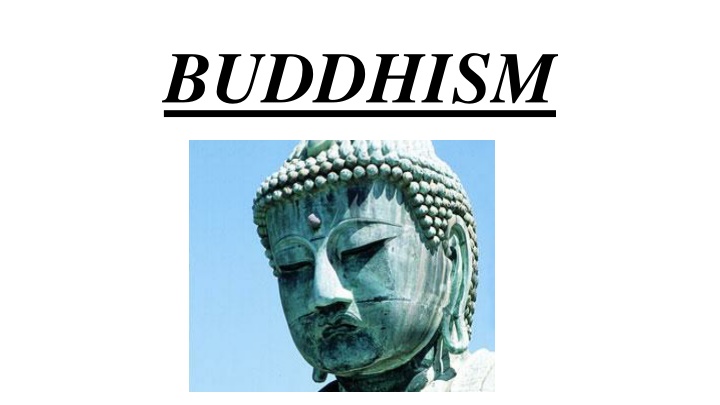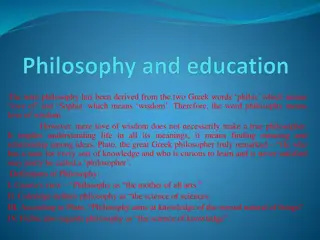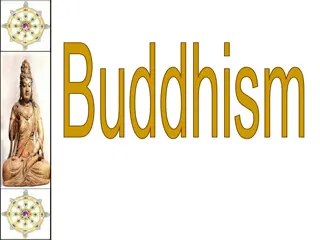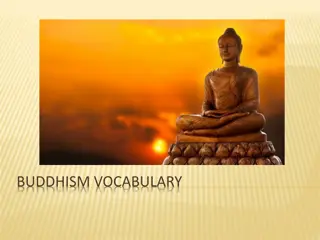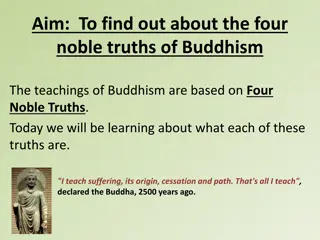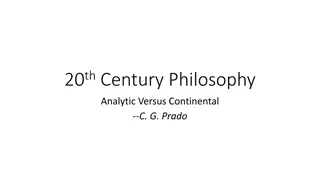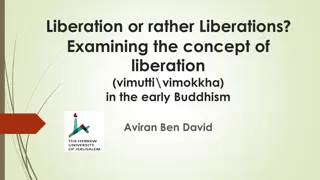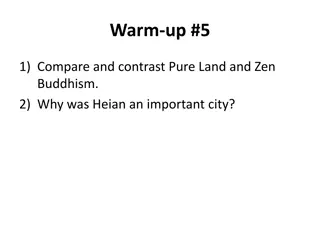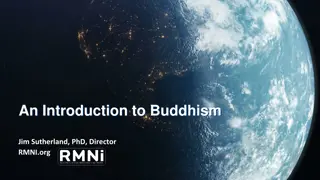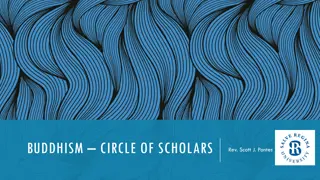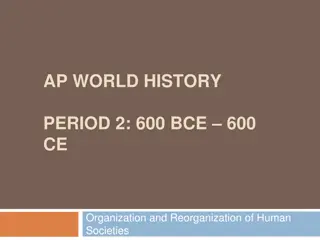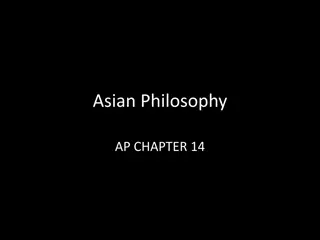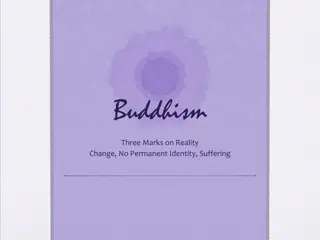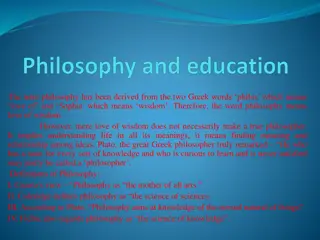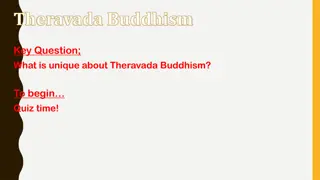Insights into Buddhism: History, Philosophy, and Schools
Buddhism, a spiritual tradition focused on personal development and attaining deep insight into life, boasts 376 million followers globally. Rooted in the teachings of the Buddha, it emphasizes reaching nirvana through morality, meditation, and wisdom. The history of Buddhism traces back to Siddhartha Gautama, who renounced a life of luxury to seek enlightenment and founded the faith. With diverse schools like Theravada and Mahayana, Buddhism offers various paths towards enlightenment, devoid of a belief in a personal god.
Download Presentation

Please find below an Image/Link to download the presentation.
The content on the website is provided AS IS for your information and personal use only. It may not be sold, licensed, or shared on other websites without obtaining consent from the author.If you encounter any issues during the download, it is possible that the publisher has removed the file from their server.
You are allowed to download the files provided on this website for personal or commercial use, subject to the condition that they are used lawfully. All files are the property of their respective owners.
The content on the website is provided AS IS for your information and personal use only. It may not be sold, licensed, or shared on other websites without obtaining consent from the author.
E N D
Presentation Transcript
Buddhism at a Glance Buddhism is a spiritual tradition that focuses on personal spiritual development and the attainment of a deep insight into the true nature of life. There are 376 million followers worldwide. Buddhists seek to reach a state of nirvana, following the path of the Buddha, Siddhartha Gautama, who went on a quest for Enlightenment around the sixth century BC. There is no belief in a personal god. Buddhists believe that nothing is fixed or permanent and that change is always possible. The path to Enlightenment is through the practice and development of morality, meditation and wisdom. Buddhists believe that life is both endless and subject to impermanence, suffering and uncertainty. These states are called the tilakhana, or the three signs of existence. Existence is endless because individuals are reincarnated over and over again, experiencing suffering throughout many lives. It is impermanent because no state, good or bad, lasts forever. Our mistaken belief that things can last is a chief cause of suffering.
History of Buddhism Siddhartha Gautama, the Buddha, was born into a royal family in present- day Nepal over 2500 years ago. He lived a life of privilege and luxury until one day he left the royal enclosure and encountered for the first time, an old man, a sick man, and a corpse. Disturbed by this he became a monk before adopting the harsh poverty of Indian asceticism. Neither path satisfied him and he decided to pursue the Middle Way - a life without luxury but also without poverty. Buddhists believe that one day, seated beneath the Bodhi tree (the tree of awakening), Siddhartha became deeply absorbed in meditation and reflected on his experience of life until he became enlightened. By finding the path to enlightenment, Siddhartha was led from the pain of suffering and rebirth towards the path of enlightenment and became known as the Buddha or 'awakened one'.
The Buddha Siddhartha Gautama, the Buddha, was born into a royal family in present- day Nepal over 2500 years ago. He lived a life of privilege and luxury until one day he left the royal enclosure and encountered for the first time, an old man, a sick man, and a corpse. Disturbed by this he became a monk before adopting the harsh poverty of Indian asceticism. Neither path satisfied him and he decided to pursue the Middle Way - a life without luxury but also without poverty. Buddhists believe that one day, seated beneath the Bodhi tree (the tree of awakening), Siddhartha became deeply absorbed in meditation and reflected on his experience of life until he became enlightened. By finding the path to enlightenment, Siddhartha was led from the pain of suffering and rebirth towards the path of enlightenment and became known as the Buddha or 'awakened one'.
Schools of Buddhism There are numerous different schools or sects of Buddhism. The two largest are Theravada Buddhism, which is most popular in Sri Lanka, Cambodia, Thailand, Laos and Burma (Myanmar), and Mahayana Buddhism, which is strongest in Tibet, China, Taiwan, Japan, Korea, and Mongolia. The majority of Buddhist sects do not seek to proselytize (preach and convert), with the notable exception of Nichiren Buddhism. All schools of Buddhism seek to aid followers on a path of enlightenment.
Buddhism: Key Facts Buddhism is 2,500 years old There are currently 376 million followers worldwide Buddhism arose as a result of Siddhartha Gautama's quest for Enlightenment in around the 6th Century BC There is no belief in a personal God. It is not centered on the relationship between humanity and God Buddhists believe that nothing is fixed or permanent - change is always possible The two main Buddhist sects are Theravada Buddhism and Mahayana Buddhism, but there are many more Buddhists can worship both at home or at a temple The path to Enlightenment is through the practice and development of morality, meditation and wisdom.
The First Noble Truth: Suffering (Dukkha) Suffering comes in many forms. Three obvious kinds of suffering correspond to the first three sights the Buddha saw on his first journey outside his palace: old age, sickness and death. But according to the Buddha, the problem of suffering goes much deeper. Life is not ideal: it frequently fails to live up to our expectations. Human beings are subject to desires and cravings, but even when we are able to satisfy these desires, the satisfaction is only temporary. Pleasure does not last; or if it does, it becomes monotonous. Even when we are not suffering from outward causes like illness or bereavement, we are unfulfilled, unsatisfied. This is the truth of suffering. Some people who encounter this teaching may find it pessimistic. Buddhists find it neither optimistic nor pessimistic, but realistic. Fortunately the Buddha's teachings do not end with suffering; rather, they go on to tell us what we can do about it and how to end it.
The Second Noble Truth: Origin of Suffering (Samud ya) Our day-to-day troubles may seem to have easily identifiable causes: thirst, pain from an injury, sadness from the loss of a loved one. In the second of his Noble Truths, though, the Buddha claimed to have found the cause of all suffering - and it is much more deeply rooted than our immediate worries. The Buddha taught that the root of all suffering is desire, tanh . This comes in three forms, which he described as the Three Roots of Evil, or the Three Fires, or the Three Poisons.
The Three Roots of Evil These are the three ultimate causes of suffering: Greed and desire, represented in art by a rooster Ignorance or delusion, represented by a pig Hatred and destructive urges, represented by a snake Language note: Tanh is a term in Pali, the language of the Buddhist scriptures, that specifically means craving or misplaced desire. Buddhists recognize that there can be positive desires, such as desire for enlightenment and good wishes for others. A neutral term for such desires is chanda.
The Third Noble Truth: Cessation of suffering (Nirodha) The Buddha taught that the way to extinguish desire, which causes suffering, is to liberate oneself from attachment. This is the third Noble Truth - the possibility of liberation. The Buddha was a living example that this is possible in a human lifetime. "Estrangement" here means disenchantment: a Buddhist aims to know sense conditions clearly as they are without becoming enchanted or misled by them.
Nirvana Nirvana means extinguishing. Attaining nirvana - reaching enlightenment - means extinguishing the three fires of greed, delusion and hatred. Someone who reaches nirvana does not immediately disappear to a heavenly realm. Nirvana is better understood as a state of mind that humans can reach. It is a state of profound spiritual joy, without negative emotions and fears. Someone who has attained enlightenment is filled with compassion for all living things. After death an enlightened person is liberated from the cycle of rebirth, but Buddhism gives no definite answers as to what happens next. The Buddha discouraged his followers from asking too many questions about nirvana. He wanted them to concentrate on the task at hand, which was freeing themselves from the cycle of suffering. Asking questions is like quibbling with the doctor who is trying to save your life.
The Fourth Noble Truth Path to the Cessation of Suffering (Magga) The final Noble Truth is the Buddha's prescription for the end of suffering. This is a set of principles called the Eightfold Path. The Eightfold Path is also called the Middle Way: it avoids both indulgence and severe asceticism, neither of which the Buddha had found helpful in his search for enlightenment.
The Eight Divisions 1. Right Understanding - Samm ditthi Accepting Buddhist teachings. (The Buddha never intended his followers to believe his teachings blindly, but to practice them and judge for themselves whether they were true.) 2. Right Intention - Samm san kappa A commitment to cultivate the right attitudes. 3. Right Speech - Samm v c Speaking truthfully, avoiding slander, gossip and abusive speech.
The Eight Divisions (continued) 4. Right Action - Samm kammanta Behaving peacefully and harmoniously; refraining from stealing, killing and overindulgence in sensual pleasure. 5. Right Livelihood - Samm j va Avoiding making a living in ways that cause harm, such as exploiting people or killing animals, or trading in intoxicants or weapons. 6. Right Effort - Samm v y ma Cultivating positive states of mind; freeing oneself from evil and unwholesome states and preventing them arising in future.
The Eight Divisions (continued) 7. Right Mindfulness - Samm sati Developing awareness of the body, sensations, feelings and states of mind. 8. Right Concentration - Samm sam dhi Developing the mental focus necessary for this awareness.
The BuddhaHis Life The history of Buddhism is the story of one man's spiritual journey to Enlightenment, and of the teachings and ways of living that developed from it. Siddhartha Gautama - The Buddha By finding the path to Enlightenment, Siddhartha was led from the pain of suffering and rebirth towards the path of Enlightenment and became known as the Buddha or 'awakened one'. A life of luxury Opinions differ as to the dates of Siddhartha Gautama's life. Historians have dated his birth and death as circa 566-486 BCE but more recent research suggests that he lived later than this, from around 490 BCE until circa 410 BCE. He was born into a royal family in the village of Lumbini in present-day Nepal, and his privileged life insulated him from the sufferings of life; sufferings such as sickness, age and death
The BuddhaHis Life (continued) Discovering cruel reality One day, after growing up, marrying and having a child, Siddhartha went outside the royal enclosure where he lived. When he went outside he saw, each for the first time, an old man, a sick man, and a corpse. This greatly disturbed him, and he learned that sickness, age, and death were the inevitable fate of human beings - a fate no-one could avoid. Becoming a holy man Siddhartha had also seen a monk, and he decided this was a sign that he should leave his protected royal life and live as a homeless holy man. Siddhartha's travels showed him much more of the the suffering of the world. He searched for a way to escape the inevitability of death, old age and pain first by studying with religious men. This didn't provide him with an answer.
The BuddhaHis Life (continued) A life of self-denial Siddhartha encountered an Indian ascetic who encouraged him to follow a life of extreme self-denial and discipline. The Buddha also practiced meditation but concluded that in themselves, the highest meditative states were not enough. Siddhartha followed this life of extreme asceticism for six years, but this did not satisfy him either; he still had not escaped from the world of suffering. The middle way He abandoned the strict lifestyle of self-denial and being ascetic, but did not return to the pampered luxury of his early life. Instead, he pursued the Middle Way, which is just what it sounds like; neither luxury nor poverty.
The BuddhaHis Life (continued) Enlightenment One day, seated beneath the Bodhi tree (the tree of awakening) Siddhartha became deeply absorbed in meditation, and reflected on his experience of life, determined to penetrate its truth. He finally achieved Enlightenment and became the Buddha. The Mahabodhi Temple at the site of Buddha's enlightenment, is now a pilgrimage site. Buddhist legend tells that at first the Buddha was happy to dwell within this state, but Brahma, king of the gods, asked, on behalf of the whole world, that he should share his understanding with others.
The BuddhaHis Life (continued) The Teacher Buddha set in motion the wheel of teaching: rather than worshipping one god or gods, Buddhism centers around the timeless importance of the teaching, or the dharma. For the next 45 years of his life the Buddha taught many disciples, who became Arahants or 'noble ones', who had attained Enlightenment for themselves
Dalai Lama The Role of the Dalai Lama The Dalai Lama is the head monk of Tibetan Buddhism and traditionally has been responsible for the governing of Tibet, until the Chinese government took control in 1959. Before 1959, his official residence was Potala Palace in Lhasa, the capital of Tibet. The Dalai Lama belongs to the Gelugpa tradition of Tibetan Buddhism, which is the largest and most influential tradition in Tibet. The institution of the Dalai Lama is a relatively recent one. There have been only 14 Dalai Lamas in the history of Buddhism, and the first and second Dalai Lamas were given the title posthumously. According to Buddhist belief, the current Dalai Lama is a reincarnation of a past lama who decided to be reborn again to continue his important work, instead of moving on from the wheel of life. A person who decides to be continually reborn is known as tulku. Buddhists believe that the first tulku in this reincarnation was Gedun Drub, who lived from 1391-1474 and the second was Gendun Gyatso. However, the name Dalai Lama, meaning Ocean of Wisdom, was not conferred until the third reincarnation in the form of Sonam Gyatso in 1578. The current Dalai Lama is Tenzin Gyatso.
Subdivisions Mahayana Buddhism Pure Land Buddhism Tibetan Buddhism Korean Zen Buddhism Nichiren Buddhism Theravada Buddhism Zen Buddhism
Venerating the Buddha, Pilgrimage and Ordination Venerating the Buddha The Buddhist tradition has developed many different customs and practices in different parts of the world. This may take the form of meditating on the qualities of Buddha, and honoring the Buddha or Buddha- figure. A person could honor the Buddha by making offerings to relics or images of the Buddha.
Customs: The Exchange of Gifts In the Theravada tradition, Buddhist laypersons often give gifts to Buddhist monks but giving is also encouraged more generally, to one another and to good causes. In Theravada Buddhism, monks are considered to embody the fruits of Buddhist practice. Monks' responsibility is to share these with lay Buddhists through their example and teaching. Giving to monks is also thought to benefit lay people and to win them merit.
Customs: Pilgrimage Four main centers of pilgrimage sprung up within the first couple of hundred years after Buddha's death which marked key locations in the Buddha's life. Since then other centers have emerged in virtually every area where Buddhism has been established, each with its own practices and customs. The purpose of pilgrimage is to foster a spiritual discipline, to fulfil a vow or simply to travel. It is an important Buddhist practice. Pilgrimage also helps to express feelings of devotion and creates a relationship with the historical figures associated with the pilgrimage site.
Customs: Ordination Admission to the monastic sangha involves two rites of passage: Renunciation of the secular life Acceptance of monasticism as a novice Since in many cases, acceptance as a monk could not be made before the age of 20, the two rites could be separated by many years. Ordination is an important ceremony in all traditions. In the Theravada, for example, ordination means becoming a monk. To become a Theravadin monk a postulant shaves his head and beard and adopts the yellow robes of the monk. Various vows are exchanged, including the repetition of the Ten Precepts. Then the postulant is questioned about past behavior and their suitability for the position. If satisfied, the officiating abbot admits the postulant.
Abortion There is no single Buddhist view on abortion. Buddhists believe that life should not be destroyed, but they regard causing death as morally wrong only if the death is caused deliberately or by negligence. Traditional Buddhism rejects abortion because it involves the deliberate destroying of a life. Buddhists regard life as starting at conception.
Capital Punishment Because Buddhism exists in many forms, under many organizations, there is no unified Buddhist policy on capital punishment. In terms of doctrine the death penalty is clearly inconsistent with Buddhist teaching. Buddhists place great emphasis on non-violence and compassion for all life. The First Precept requires individuals to abstain from injuring or killing any living creature. The Buddha did not explicitly speak about capital punishment, but his teachings show no sympathy for physical punishment, no matter how bad the crime. As far as punishment in this world is concerned, Buddhism has strong views: inhumane treatment of an offender does not solve their misdeeds or those of humanity in general - the best approach to an offender is reformatory rather than punitive punishment should only be to the extent to which the offender needs to make amends, and his rehabilitation into society should be of paramount importance punishing an offender with excessive cruelty will injure not just the offender's mind, but also the mind of the person doing the punishing it is impossible to administer severe punishment with composure and compassion if the crime is particularly serious, the person may be banished from the community or country
Euthanasia, Assisted Dying, and Suicide Buddhists are not unanimous in their view of euthanasia, and the teachings of the Buddha don't explicitly deal with it. Most Buddhists (like almost everyone else) are against involuntary euthanasia. Their position on voluntary euthanasia is less clear. States of mind The most common position is that voluntary euthanasia is wrong, because it demonstrates that one's mind is in a bad state and that one has allowed physical suffering to cause mental suffering. Meditation and the proper use of pain killing drugs should enable a person to attain a state where they are not in mental pain, and so no longer contemplate euthanasia or suicide. Buddhists might also argue that helping to end someone's life is likely to put the helper into a bad mental state, and this too should be avoided. Avoiding harm Buddhism places great stress on non-harm, and on avoiding the ending of life. The reference is to life - any life - so the intentional ending of life seems against Buddhist teaching and voluntary euthanasia should be forbidden. Certain codes of Buddhist monastic law explicitly forbid it. Lay-people do not have a code of Buddhist law, so the strongest that can be said of a lay person who takes part in euthanasia is that they have made an error of judgement. Karma Buddhists regard death as a transition. The deceased person will be reborn to a new life, whose quality will be the result of their karma. This produces two problems. We don't know what the next life is going to be like. If the next life is going to be even worse than the life that the sick person is presently enduring it would clearly be wrong on a utilitarian basis to permit euthanasia, as that shortens the present bad state of affairs in favor of an even worse one. The second problem is that shortening life interferes with the working out of karma, and alters the karmic balance resulting from the shortened life. Euthanasia as suicide Another difficulty comes if we look at voluntary euthanasia as a form of suicide. The Buddha himself showed tolerance of suicide by monks in two cases. The Japanese Buddhist tradition includes many stories of suicide by monks, and suicide was used as a political weapon by Buddhist monks during the Vietnam war. But these were monks, and that makes a difference. In Buddhism, the way life ends has a profound impact on the way the new life will begin. So a person's state of mind at the time of death is important - their thoughts should be selfless and enlightened, free of anger, hate or fear. This suggests that suicide (and so euthanasia) is only approved for people who have achieved enlightenment and that the rest of us should avoid it.
Animals Buddhists try to do no harm (or as little harm as possible) to animals Buddhists try to show loving-kindness to all beings, including animals The doctrine of right livelihood teaches Buddhists to avoid any work connected with the killing of animals The doctrine of karma teaches that any wrong behavior will have to be paid for in a future life - so cruel acts to animals should be avoided Buddhists treat the lives of human and non-human animals with equal respect Buddhists see human and non-human animals as closely related: both have Buddha-nature both have the possibility of becoming perfectly enlightened a soul may be reborn either in a human body or in the body of a non-human animal Buddhists believe that is wrong to hurt or kill animals, because all beings are afraid of injury and death.
War Non-violence is at the heart of Buddhist thinking and behavior. The first of the five precepts that all Buddhists should follow is "Avoid killing, or harming any living thing." Buddhism is essentially a peaceful tradition. Nothing in Buddhist scripture gives any support to the use of violence as a way to resolve conflict Many Buddhists have refused to take up arms under any circumstances, even knowing that they would be killed as a result. The Buddhist code that governs the life of monks permits them to defend themselves, but it forbids them to kill, even in self-defense. For Buddhist countries this poses the difficult dilemma of how to protect the rights and lives of their citizens without breaking the principle of nonviolence.
